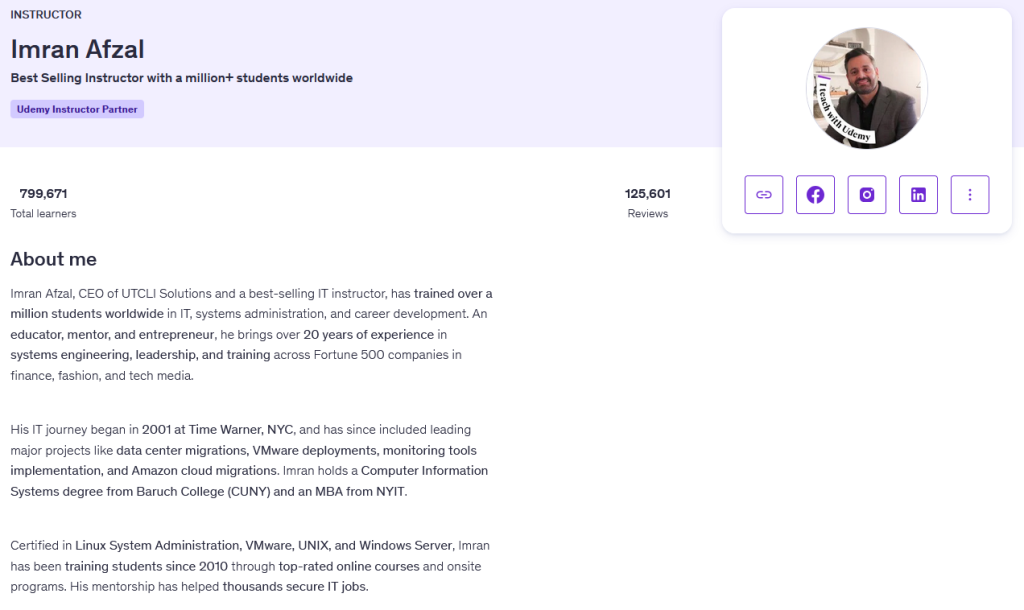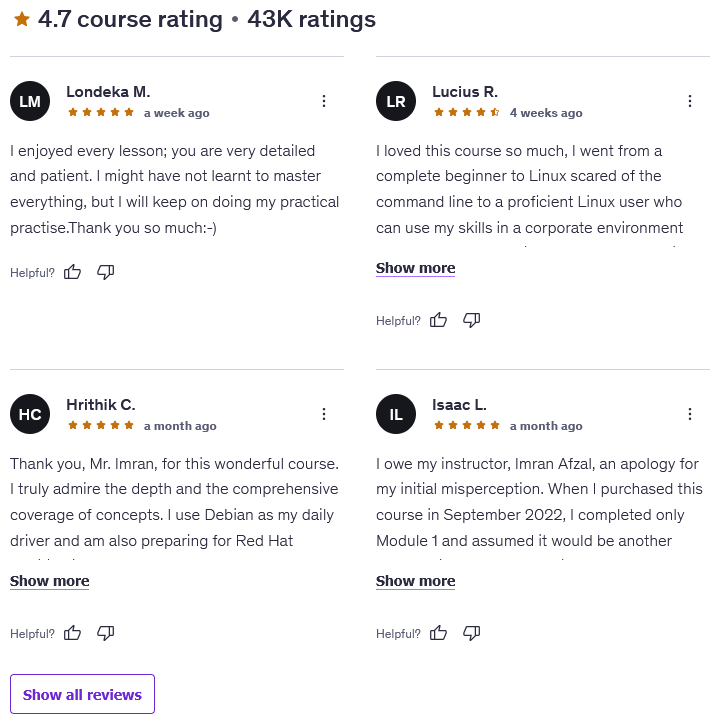If you’re hunting for a beginner-friendly but career-oriented Linux path, Complete Linux Training Course to Get Your Dream IT Job 2025 feels like a solid bet. It starts at true zero—installing a distro in VirtualBox—and builds you up to shell scripting, server services, and the certs hiring managers recognize (RHCSA, RHCE, LFCS, LPIC, and Linux+). The vibe is classroom-style and practical, with handouts, homework, and interview/resume workshops baked in so you’re not just learning commands—you’re getting job-ready.
Instructor Reputation
When it comes to learning Linux online, instructor credibility matters a lot—and Imran Afzal stands out as one of Udemy’s most respected names in IT training. With more than a million students, 125,000+ reviews, and 57 courses, his teaching career has reached nearly every corner of the globe. But numbers aside, what really defines his reputation is how he teaches and what results his students actually get.

Imran’s background isn’t just academic—he has over 20 years of real-world experience in enterprise environments, including work with Fortune 500 companies in finance, fashion, and media. His roles have included system engineering, data center migrations, VMware deployments, and major cloud transitions for Amazon Web Services (AWS). That breadth of experience shows in the way he structures explanations: he doesn’t just throw theory at you, he explains why things matter and ties them back to real IT workflows.
Students constantly highlight his teaching style as patient, practical, and genuinely engaging. Many call him the best instructor they’ve ever had—not just online, but across all forms of education. His lectures mix humor, analogies, and relatable real-world stories, keeping even dense topics like permissions, LVM, and shell scripting surprisingly digestible. One student described him as “the rare instructor who can make file systems feel fun,” which says a lot about his energy and clarity.
Beyond the screen, Imran’s passion for mentorship runs deep. He’s the founder of UTCLI Solutions, a company focused on IT training and corporate consulting, and he even opened a non-profit school for children (Pre-K to 10th grade)—a reflection of his dedication to education beyond just career training.
What also makes him stand out is his career-focused approach. Unlike most tech instructors who stop at the final lab, Imran goes further: he teaches resume writing, interview skills, and how to position yourself for Linux jobs. According to him, around 70% of students who’ve taken this course in a classroom setting have gone on to land IT roles shortly afterward—a claim that student testimonials strongly support.
These aren’t fluffy reviews, either. Students consistently share concrete outcomes: landing Linux admin jobs at IBM, passing CompTIA Linux+, clearing RHCSA exams, and switching from non-tech backgrounds into IT roles within months. That level of transformation—and the consistency of those stories—speaks volumes about the course’s effectiveness and his credibility as an educator.
To put it simply, Imran Afzal isn’t just teaching Linux commands—he’s teaching career transformation. His authenticity, combined with decades of industry experience and a proven teaching framework, has built him a reputation as one of the most trusted Linux instructors on the internet.
Course Structure
The Complete Linux Training Course to Get Your Dream IT Job 2025 is an enormous, well-organized journey through the Linux ecosystem—from total beginner setup to professional system administration. It’s not one of those “five-hour crash courses” that only scratch the surface. Instead, this course feels like an entire semester of practical, career-level Linux training condensed into one continuous, self-paced program.

The content is divided into 10 core modules, each with homework, quizzes, and handouts. The layout follows a logical path that mirrors how a real Linux admin grows—first learning the environment, then commands, scripting, services, networking, and finally the professional skills needed to land a job.
Here’s a closer look at the structure:
Module 1 – Understanding Linux Concepts
The course begins at square one, introducing what Linux is, how it differs from Unix and Windows, and where it fits in today’s tech world. Imran uses clear, real-world examples—explaining how Linux runs behind most servers, Android devices, and cloud infrastructure. This module also sets the tone for the course’s hands-on rhythm, with short quizzes and homework to reinforce retention.
Module 2 – Download, Install, and Configure Linux
You’ll install Linux using Oracle VirtualBox, setting up a virtual environment so you can safely experiment. Multiple distributions—CentOS, CentOS Stream, and Red Hat—are covered, giving you practical flexibility for both corporate and exam contexts. You’ll also learn how to manage virtual machines, use GUI vs. CLI environments, and understand how Linux setups differ from Windows.
Module 3 – System Access and File System
This module is where students start feeling like real admins. You’ll connect to Linux using PuTTY, navigate directories, manipulate files, and understand system structure. Commands like find, locate, ln, and cat become second nature here. You’ll also learn wildcards, password management, and soft/hard links—core skills for any admin.
Module 4 – Linux Fundamentals
Here, the focus shifts to mastering commands and permissions. You’ll explore syntax, ownership, and the power of chmod, chown, and chgrp. Then comes piping, filtering, and text manipulation with grep, awk, and cut. Imran takes the time to explain how Linux command structures encourage problem-solving and efficiency, which is why employers love candidates who think “the Linux way.”
Module 5 – System Administration
This is one of the biggest and most important parts of the course. You’ll get into user management, process control, system utilities, and monitoring tools like top, df, and iostat. You’ll learn how to manage scheduled tasks with cron, switch users securely, and even recover the root password in single-user mode. Imran also touches on authentication services like LDAP and Active Directory integration, giving you real corporate-world exposure.
Module 6 – Shell Scripting
A standout for many students. By now you’re comfortable with commands, so you’ll start automating them. This section goes from basic scripts to conditionals (if, for, case, while) and practical examples like log rotation, backups, and user management. These scripting exercises are not just academic—they’re the kind of tasks junior sysadmins do on the job.
Module 7 – Networking, Servers, and System Updates
This is where the course expands beyond the local system. You’ll configure network settings, explore tools like ping, netstat, tcpdump, and ethtool, and learn how to troubleshoot connections. You’ll set up Apache web servers, DNS, NTP, and secure remote access via SSH. Imran also covers patch management, repositories, and OS hardening—skills crucial for corporate compliance.
Module 8 – Disk Management and Run Levels
Storage management and system startup processes are the stars here. You’ll learn partitioning, LVM (Logical Volume Management), adding swap space, and even configuring RAID arrays. For anyone pursuing RHCSA or Linux+, this is essential knowledge—and the way Imran explains these concepts visually and practically is one of the reasons this module gets so much praise.
Module 9 – All About Resume
Unlike most technical courses, this one shifts gears to career preparation. Imran walks you through resume structure, crafting a strong cover letter, and identifying the right keywords to stand out in job searches. There are handouts with example resumes for Linux admins and sysadmins.
Module 10 – All About Interview
The final stretch is where everything ties together. You’ll go over IT job market trends, learn how to post your resume effectively, and prepare for interviews with 200+ curated Linux questions. Imran even explains what hiring managers look for, helping you anticipate both technical and behavioral questions.
Recap and Additional Resources
After finishing the main content, you get a recap of all commands covered—over 300 commands total—plus handouts and extra lectures. This makes the course an excellent long-term reference, not just a one-and-done class.
Overall, the structure of this course is what makes it feel complete. Each module connects logically to the next, combining clear explanations with practical exercises, quizzes, and homework. Even complex topics like LVM, RAID, or LDAP are introduced at just the right pace, so you’re never overwhelmed.
If you treat it seriously, this course functions as an entire Linux bootcamp: it starts from your first terminal login and ends with you being ready for certification exams and real sysadmin work. Many students even call it “the only Linux course you’ll ever need”—and based on how thoroughly it’s built, that’s not an exaggeration.
Content Quality
When it comes to content depth and teaching clarity, Complete Linux Training Course to Get Your Dream IT Job 2025 punches far above what you’d expect from a Udemy course. The structure feels almost like a multi-week bootcamp carefully translated into a self-paced online format. Every topic—no matter how complex—is broken down into approachable, digestible lessons with live demos, homework, and real-world scenarios.

The first thing you notice is the balance between theory and hands-on practice. Imran doesn’t just tell you what a command does; he opens up the terminal, shows you how it behaves, and explains why it matters. That simple yet consistent approach is what makes his course stick with students long after completion. You’re not memorizing lists of commands—you’re learning habits and logic you can actually use in the field.
There’s a strong progressive learning curve, too. You start with simple concepts—what Linux is, how to install it, and how the file system works—but before you know it, you’re managing users, automating processes, writing scripts, configuring servers, setting up LVM partitions, and even hardening systems for security. Every module builds seamlessly on the one before it, and the pacing feels deliberate. It never assumes prior experience, but it also never slows down so much that you get bored.
Another standout is how much career relevance is baked in. Many technical courses end once you know the commands. Imran goes several steps further by integrating resume and interview workshops, real-world project references, and step-by-step guidance for passing industry certifications like RHCSA, RHCE, LFCS, LPIC, and Linux+. He doesn’t just prepare you to learn Linux—he prepares you to get hired with Linux.
Students repeatedly mention how the course bridges the gap between “I kind of understand this” and “I can actually do this in production.” You’ll work through configuration exercises that mirror real sysadmin tasks: managing users and permissions, monitoring performance with top and iostat, creating cron jobs, setting up Apache, configuring RAID and LVM, and troubleshooting network issues. These tasks make you think like an administrator rather than a passive learner.
A big strength here is the sheer comprehensiveness. Over 300 commands are covered, with each command’s purpose demonstrated in context. There are full sections on shell scripting, networking, and service configuration—topics that many beginner courses gloss over. And for each of these, you get supporting handouts and quizzes to reinforce the lessons.
The production quality is solid—clear audio, clean screen recordings, and minimal filler. Imran’s voice and teaching style make the content feel more like a conversation than a lecture. Occasionally, you’ll run into older commands or quiz references that could use an update for the newest Linux distributions, but these moments are rare and don’t impact the value of what’s being taught. If anything, they can actually help learners understand compatibility differences across versions (like Red Hat 7 vs. 9).
You can tell that the course has evolved over time. Some lectures have been re-recorded and expanded, and new materials have been added as Linux itself has changed. There’s also a generous supply of bonus content and extra resources—everything from handouts of command summaries to PDF checklists for troubleshooting common issues. These make the course a long-term resource, not something you’ll finish and forget.
Another point worth noting: Imran’s teaching personality brings a lot of energy to otherwise dry topics. His real-world examples—sometimes referencing pop culture or workplace stories—break up the technical monotony. Students consistently say he’s both funny and motivating, and that his tone makes difficult material surprisingly accessible.
In short, the content quality here is top-notch. It’s comprehensive without being overwhelming, engaging without being superficial, and structured to genuinely make you job-ready. You finish not just knowing Linux, but feeling confident enough to use it—exactly what most learners are hoping for when they click “Enroll.”
Overall Course Rating – 9.5/10
If I had to put a number on it, I’d give Complete Linux Training Course to Get Your Dream IT Job 2025 a 9.5 out of 10. It’s one of those rare Udemy courses that doesn’t just teach—you can tell it’s been refined and perfected over time based on real student outcomes. The high rating comes from how well it balances depth, structure, and career relevance. It’s accessible for beginners, yet detailed enough for those chasing professional certifications or aiming to move into system administration roles.

What makes this course exceptional is how practical it is from start to finish. You’re never stuck in “theory land.” Every concept connects to something you’ll actually do in a real job—whether that’s editing files in vi, configuring a web server, writing a shell script, or managing users on a production system. The progression from basic commands to complex admin tasks feels natural and empowering.
This course also goes far beyond technical skill-building. The resume workshop and interview module transform it from just another Linux tutorial into a true career accelerator. Students who came in nervous about the command line often end up with Linux certifications, job offers, and the confidence to handle interviews. The fact that so many graduates have transitioned into roles at major companies like IBM, UST Global, and others is strong proof of its real-world value.
Where this course particularly shines is in its inclusivity—it’s built for total beginners but manages to keep intermediate learners engaged too. The sections on LVM, RAID, networking, and Apache web servers give you genuine administrator experience. The shell scripting module is another standout, since automation is an essential skill that employers actively look for.
There are a few minor areas that could be improved—mainly the occasional outdated command in a quiz or an older demo of a specific Linux release—but these are small details in an otherwise incredibly polished and comprehensive learning package. They don’t distract from the core message or the value you’re getting.
Another reason this course deserves such a high score is its consistency in student satisfaction. Across thousands of reviews, learners describe genuine transformations: going from complete Linux novices to certified professionals or newly hired admins. That kind of result isn’t common with most online courses. It shows that Imran’s method—detailed explanations, guided labs, and a focus on employability—really works.
Finally, this course provides something that’s hard to find online: a sense of mentorship. Imran doesn’t just throw information at you; he roots for your success. His personality, energy, and depth of knowledge make it feel like you’re in a classroom with someone who truly wants you to succeed in IT. That personal touch is part of what elevates the entire experience.
Overall, this course is an absolute must for anyone serious about learning Linux from the ground up. Whether your goal is certification, a new job, or simply mastering one of the most powerful operating systems in the world, this training gives you everything you need—and then some.



